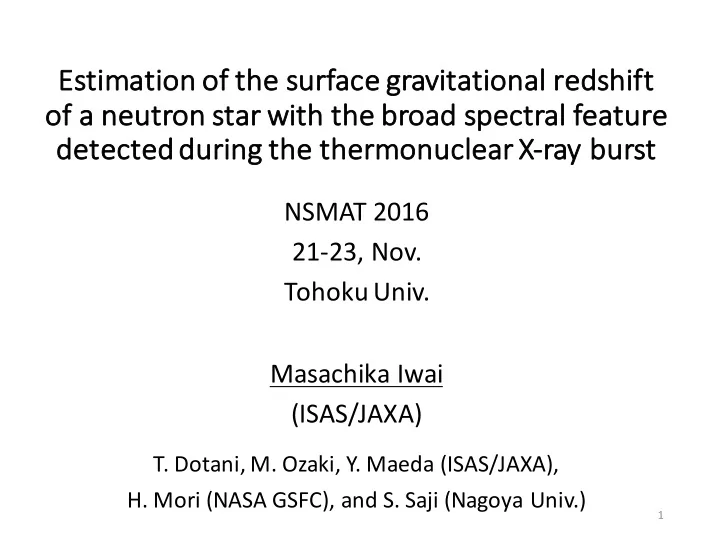

Es Estimation n of the he sur urface gravitationa nal reds dshi hift of of a neutron on star with the broa oad spectral feature de detected d dur during ng the he the hermonuc nuclear X-ra ray burs rst NSMAT 2016 21-23, Nov. Tohoku Univ. Masachika Iwai (ISAS/JAXA) T. Dotani, M. Ozaki, Y. Maeda (ISAS/JAXA), H. Mori (NASA GSFC), and S. Saji (Nagoya Univ.) 1
Introduction Corresponding to the mass-radius • Past studies ratio of a neutron star Identification of the lines Surface gravitational redshifts Tried to detect absorption can be derived immediately. lines in the burst spectra • Difficulties Most of burst sources are rapidly spinning: ~200-600 Hz Absorption lines formed on the neutron star surface may be smeared out and may not be detected. We must carefully select a slowly spinning burst source. Terzan 5 X-2 (11 Hz ): • Breakthrough in this study a transient source. We will focus on absorption edges in the burst spectra. Absorption edges may be detected even Intrinsically broad! from the rapidly spinning burst sources. 2
An X-ray burst from GRS 1747−312 detected with Suzaku GRS 1747−312 is a transient source in the globular cluster Terzan 6 • (Predehl et al. 1991; Pavlinskyet al. 1994). In a low-luminosity state During a part of Galactic bulge mapping observations, GRS 1747−312 was • included in Suzaku field of view and a long X-ray burst was unexpectedly detected. CCD camera onboard Suzaku Close-up light curve Light curve obtained with XIS During the burst Sep. 2009 0.5 − 10 keV 100 100 80 A burst detected The data after 192 sec From GRS 1747−312 Counts s -1 was not obtained. Counts s -1 10 60 A 40 1 20 e-folding time: 117 +- 6 sec 0 0.1 0 50 100 150 200 0 × 10 0 5 × 10 4 1 × 10 5 Seconds since 2009/09/17 01:20:07 3 Seconds since 2009/09/16 07:22:51
・ First half of the burst Properties of ü A clear PRE (PhotosphericRadius Expansion) the X-ray burst ü The burst spectra are well-reproduced by the blackbody model. L 〜 L Edd Bolometric ・ Latter half of ,9.5 kpc luminosity [10 38 erg s -1 ] 4 Photosphere returns to the burst 3 B the neutron star surface. L bol 2 ü No PRE 1 ü Large deviations due to a broad feature 0 at > 6 keV were observed. Color-temperature 3 Poor fit! [keV] 2 = 2.21) kT c bbody model ( χ ν 2 10 3 A clear PRE occured 1 In initial 80 sec 10 2 Counts s -1 keV -1 9.5 kpc XIS1 ( × 20) 30 Photospheric radius 20 10 1 [km] R 10 XIS0+3 10 0 Deviations from 0 2 blackbody model A broad feature 10 -1 1.5 ν χ 2 2 1 Large deviations Ratio 1.5 0.5 1 0.5 0 50 100 150 200 1 2 5 7 10 12 Seconds since 2009/09/17 01:20:07 Energy [keV] 4 Burst parameters and their time-variations Average burst spectrum during time-region B
A likely origin of the spectral feature We tried various models and found that the double absorption edges smeared by the rapid neutron star spin is the most likely scenario. Good fit! Other scenarios cannot be rejected Data/Model The residual disappears! completely due to the lack of high-energy coverage in the latter half of the burst. 7 5 10 12 1 Energy (keV) Emergence of the spectral feature was explained naturally by the change of • the ionization degrees Fully ionized in the first half H-like/He-like ions in the latter half Obtained parameters: • ü Continuum : ~2 keV bbodywith Nh = ~1.3E22 cm-2 ü Absorption edges : 6.1+-0.2 keV with τ opt = ~1 & 7.8+-0.2 keV with τ opt = ~3 ü Spin frequency : 800+-200 Hz 5
Numerical results of nuclear network calculations Estimation of the surface during the burst by Weinberg et al. (2006) gravitational redshift Composition of burst products Mass Fraction Ions responsible for the edges are determined by referring numerical calculations. ・ E edge (6.1 keV & 7.8 keV) He0.1 HHe0.1 ・ ΔE edge Depth from Neutron Star surfaces (g cm -2 ) Possible combination of ions: The observational constraints H-like Fe (9.28 keV) & H-like Zn (12.39 keV) obtained from this work 2.5 MPA1 GR AP3 PAL1 MS0 MS2 ∞ ENG < P AP4 2 3 0 Surface gravitational red shift: causality . 0 ± 6 Mass (M ◉ ) 5 MS1 . 1 = FSU z • ) + 1 1.56 +- 0.03 Mass (M o GM3 PAL6 1.5 GS1 Combining the gravitational redshift 1 SQM1 SQM3 with other parameters, we may obtain J1748 − 2446ad(716Hz) Adapted from constraints on the equation of state of 0.5 rotation Lattimer & Prakash 2007 the neutron star matter. 0 8 10 12 14 16 6 Radius (km) Radius (km)
Future plans & Summary Future plans • We need to increase number of observations of absorption edges in the bursts. ü We will plan to use the data of the NuSTAR satellite. Summary • We detected the X-ray burst from GRS 1747−312 with Suzaku serendipitously. • A broad spectral feature was found in the latter half of the burst. ü We interpret that the feature is due to double absorption edges, which are smeared by the rapid spin of the neutron star. ü If H-like Fe & Zn are responsible for the feature, the surface gravitational redshift is estimated as 1.56+-0.03. As absorption edges are not completely smeared out even for the rapidly spinning neutron star, this can be a powerful tool to measure the surface gravitational redshifts of a neutron star. 7
Recommend
More recommend